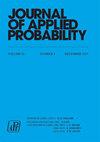A first-passage-place problem for integrated diffusion processes
IF 0.7
4区 数学
Q3 STATISTICS & PROBABILITY
引用次数: 0
Abstract
Let ${\mathrm{d}} X(t) = -Y(t) \, {\mathrm{d}} t$ , where Y(t) is a one-dimensional diffusion process, and let $\tau(x,y)$ be the first time the process (X(t), Y(t)), starting from (x, y), leaves a subset of the first quadrant. The problem of computing the probability $p(x,y)\,:\!=\, \mathbb{P}[X(\tau(x,y))=0]$ is considered. The Laplace transform of the function p(x, y) is obtained in important particular cases, and it is shown that the transform can at least be inverted numerically. Explicit expressions for the Laplace transform of $\mathbb{E}[\tau(x,y)]$ and of the moment-generating function of $\tau(x,y)$ can also be derived.积分扩散过程的一个首次通过位置问题
设${\mathrm{d}}X(t)=-Y(t)\,{\mathrm{d}t$,其中Y(t)是一维扩散过程,设$\tau(X,Y)$是从(X,Y)开始的过程第一次离开第一象限的子集。概率$p(x,y)\,:\!=\的计算问题,\mathb{P}[X](\tau(X,y))=0]$。在重要的特殊情况下,得到了函数p(x,y)的拉普拉斯变换,并表明该变换至少可以在数值上反演。也可以导出$\mathbb{E}[\tau(x,y)]$的拉普拉斯变换和$\tau(x,y)$的矩生成函数的显式表达式。
本文章由计算机程序翻译,如有差异,请以英文原文为准。
求助全文
约1分钟内获得全文
求助全文
来源期刊

Journal of Applied Probability
数学-统计学与概率论
CiteScore
1.50
自引率
10.00%
发文量
92
审稿时长
6-12 weeks
期刊介绍:
Journal of Applied Probability is the oldest journal devoted to the publication of research in the field of applied probability. It is an international journal published by the Applied Probability Trust, and it serves as a companion publication to the Advances in Applied Probability. Its wide audience includes leading researchers across the entire spectrum of applied probability, including biosciences applications, operations research, telecommunications, computer science, engineering, epidemiology, financial mathematics, the physical and social sciences, and any field where stochastic modeling is used.
A submission to Applied Probability represents a submission that may, at the Editor-in-Chief’s discretion, appear in either the Journal of Applied Probability or the Advances in Applied Probability. Typically, shorter papers appear in the Journal, with longer contributions appearing in the Advances.
 求助内容:
求助内容: 应助结果提醒方式:
应助结果提醒方式:


